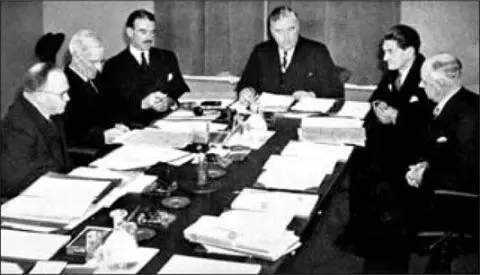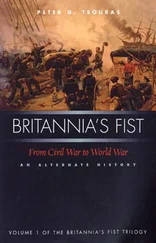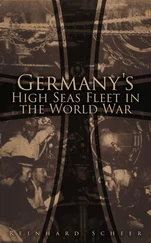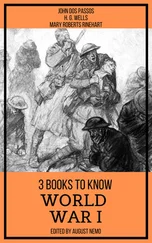In it [the French request] are involved the questions of what are our war aims, and what form of peace settlement are we determined to achieve. On these questions there are two opposite schools of thought:
a) Those who visualise a world after the war very similar to that which existed before it, but with Germany disarmed and Europe freed from fear of further German aggression.
b) Those who visualise a new world resulting from a peace settlement which had faced the vital problems of disarmament, territorial adjustment, Colonies and the economic needs of all nations, in which Germany would play an appropriate part as a great nation.
Those who support (a) would argue that history shows Germans and not merely the Nazis stand for aggression, and that we must now once and for all put them in a position where they will not be able to trouble Europe again. This can only be done by defeating, disarming, and perhaps dismembering Germany. This view takes no account of the position of Italy or Japan.
Those who support (b) argue that if lasting peace is to be established all issues must be faced, reliance on force abandoned and new conceptions of international relations and obligations set up. They consider our war aims and the basis of the peace settlement should be announced as soon as possible before war passions take control, and so that they have an effective appeal to the German people. 17
Winston Churchill and his supporters were strongly in favour of course (a), and viewed anyone with the opposite view as an appeaser. Bruce and Menzies, on the other hand, were instinctively in favour of course (b). On 18 August, Menzies cabled the British Prime Minister, Neville Chamberlain:
My Government has noted with deep interest the report of peace moves for the settlement of various European questions and knows that the British Government will use every endeavour to take advantage of such moves. In particular we consider that efforts should be made to ensure that Poland adopts a reasonable and restrained attitude and that no nation should ignore real efforts at settlement because of false notions of prestige. 18
Menzies also made the point that such efforts for peace should not be misinterpreted by Hitler as signs of weakness. On 2 January 1940 Bruce sent Menzies a long letter in which he reiterated the desirability of following course (b), in particular making a clear statement of war aims which would not anger the German people generally. 19Menzies wrote to Bruce on 22 February:
In consequence of your letter of 2 January and related cables, I had some discussion about the whole matter, but found them quite unresponsive [i.e. opposed] . There is among them a growing feeling in favour of the hard-line approach, and an almost pathetic belief that the dismemberment of Germany would alter the German spirit and outlook.
My impression from your communications is that Chamberlain and Halifax are very largely in accord with your and my views, while Winston is opposed to them. I cannot tell you adequately how much I am convinced Winston is a menace. He is a publicity seeker; he stirs up hatreds in a world already seething with them, and he is lacking in judgement. 20
Menzies clearly did not employ a ‘boots and all’ approach to preparing the nation for war. This is all too apparent during the first year of global conflict.
Resources
In 1939 the population of Australia totalled approximately seven million. The estimated Australian workforce in 1939, however, was a mere three million people. 21That workforce had to meet the requirements of at least the major employment categories of rural, including agriculture, forestry, and mining; manufacturing; services including health, retail, utilities, education; and the armed forces. The rural sector had to produce food for export as well as for internal consumption; manufacturing had to maintain supplies for normal civilian needs and also had to produce munitions of all kinds for the armed forces of Australia and her allies.
Civilian services had to maintain a reasonable standard of living in the country. At the same time there was massive demand for personnel for the three armed services. A rule of thumb suggested that an industrial nation such as Australia could spare one in ten of its population for the armed forces. 22David Horner explains the significance of resources:
A major element of Australian grand strategy was the problem of national resources, particularly the allocation of manpower and the provision of equipment for the forces raised. This problem persisted throughout the war. It affected Australia’s ability to send troops to Malaya and, as the war progressed, became the most important factor in determining the magnitude and hence the location of Australia’s military effort. 23
The allocation of human resources was a matter that was constantly on the minds of the members of the War Cabinet who had to decide how the available human resources should be divided between the Army, the Navy and the Air Force. They had to estimate the relative values of a soldier, a sailor and an airman in the defence of Australia and allocate accordingly. The difficulty lay in calculating the optimum allocation for each service and each arm within the service to achieve the national defence objectives.
An extra degree of complication was added by changes in the global situation which altered the relative value of the arms and branches of the services. For example, the transfer of the principal theatre of Australian military operations to the Malay Barrier (a notional line running down the Malayan Peninsula through Singapore and the southernmost islands of Dutch East Indies) considerably reduced the opportunity to use armoured forces. The role of those tank forces also changed to one of close support to the infantry in jungle fighting.
Time
Time was grievously lost between 1919 and 1939 in preparing for and maintaining national security. The result for both Australia and Britain was that when war broke out in September 1939 they were ill-prepared to meet its challenges. Britain went through the ‘phoney war’ with a somewhat laid-back attitude until its illusions were shattered by the German invasion of Holland, France, and Belgium on 10 May 1940. This was a clear wake-up call and the British Government, now under the forceful leadership of Winston Churchill, responded with energy. 24
In Australia, the most urgent wake-up call came eighteen months later with the bombing of Pearl Harbor on 7 December 1941. During the period from September 1939 to December 1941, Australia’s armed forces had fought valiantly. The Army had fought in the Middle East, the Air Force in the skies over Britain, Germany and the Middle East, and the Navy in many oceans around the world.
But at home it was business as usual. Gavin Long comments on the attitude of Australians on the domestic front early in the war:
About one sixth of men of military age volunteered in the first uneventful seven months of the war. It is difficult to assess the sentiments of the remainder at this time, but there is evidence that the Government considered them to be unwilling to accept measures which would disturb normal business or pleasure. For example, no decisive step to reduce consumption of petrol was taken for eight months; on 6 May 1940 the Government imposed a small tax of 3d a gallon. And doubts whether all the people had their hearts in war may have seemed to receive confirmation when from March to May there was a 67-day strike on the New South Wales coalfields. 25
While much was done to develop the armed forces and the supporting munitions industry, it was a case of too little, too late.

Melbourne, 27 September 1939. Inaugural meeting of the Australian War Cabinet. From left: Senator George McLeay, Sir Henry Gullett, Richard Casey, Robert Menzies, Geoffrey Street, and Cabinet Secretary Frederick Shedden. Billy Hughes, the remaining member, was absent ( source: Hasluck, The Government and the People, 1939-1941 , p. 151).
The War Cabinet was established on 15 September 1939. 26It was responsible for the active conduct of the war, and was chaired by the Prime Minister with selected senior ministers as members. The minutes of the War Cabinet for its first two years deal with many topics relating to the prosecution of the war, but lack any real sense of urgency. This changes abruptly on 8 December 1941 and, while there is no panic, there is evidence of the Government’s very grave concern for Australia’s security.
Читать дальше













